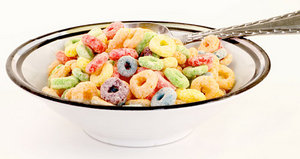What's in Your Cereal?
By Editorial Staff
As parents, we know that giving our children exactly what they want isn't always what's best for them. The conscientious parent tries to make the best choices when it comes to what their children eat and are willing to say "no" to the overly fatty, sugary or salty foods kids seem to gravitate toward. Instead, a responsible parent will provide their child with a well-balanced diet, starting with the most important meal of the day, breakfast, which commonly includes a wholesome bowl of cereal.
But do you know what's in the cereal you're feeding your children? That "Delicious and Nutritious!" message on the box may just be hype, according to a recent report that exposes what's really inside the carton (more often than not): serious spoonfuls of sugar and salt in each serving.
Consumer Reports' nutrition ratings report (November 2008 issue) found that some popular cereals marketed to children are 40-50 percent sugar, comparable to a glazed doughnut. Considering that most children eat more than the standard serving size (1 cup), your child may be consuming much more than you've bargained for.
 The report compares the nutrition information of 27 leading cereals, giving each cereal a rating of "very good," "good" or "fair." Only four of the 27 cereals were rated "very good" - General Mills' Cheerios (at the top of the list), Kix and Honey Nut Cheerios, and Quaker Oats' Life. With regard to sugar content, Post's Golden Crisp and Kellogg's Honey Smacks were rated "fair," with more than 50 percent sugar by weight per serving, and nine other cereals were determined to have at least 40 percent sugar. Kellogg's Rice Krispies, long considered a relatively healthy cereal with little sugar, rated only "fair" due to high sodium content and zero grams of dietary fiber. The report suggests parents look for cereals high in fiber (5 grams or more), low in sodium (140 milligrams or less) and low in sugar (1 teaspoon or less per serving).
The report compares the nutrition information of 27 leading cereals, giving each cereal a rating of "very good," "good" or "fair." Only four of the 27 cereals were rated "very good" - General Mills' Cheerios (at the top of the list), Kix and Honey Nut Cheerios, and Quaker Oats' Life. With regard to sugar content, Post's Golden Crisp and Kellogg's Honey Smacks were rated "fair," with more than 50 percent sugar by weight per serving, and nine other cereals were determined to have at least 40 percent sugar. Kellogg's Rice Krispies, long considered a relatively healthy cereal with little sugar, rated only "fair" due to high sodium content and zero grams of dietary fiber. The report suggests parents look for cereals high in fiber (5 grams or more), low in sodium (140 milligrams or less) and low in sugar (1 teaspoon or less per serving).
So, the next time you're strolling the cereal aisle deciding what's best for your family, spend some time reading those nutrition labels on the back of the box before tossing it into your shopping cart. The ingredients list will tell you a lot more about what's inside the box than the colorful characters and happy messages on the outside ever will.

